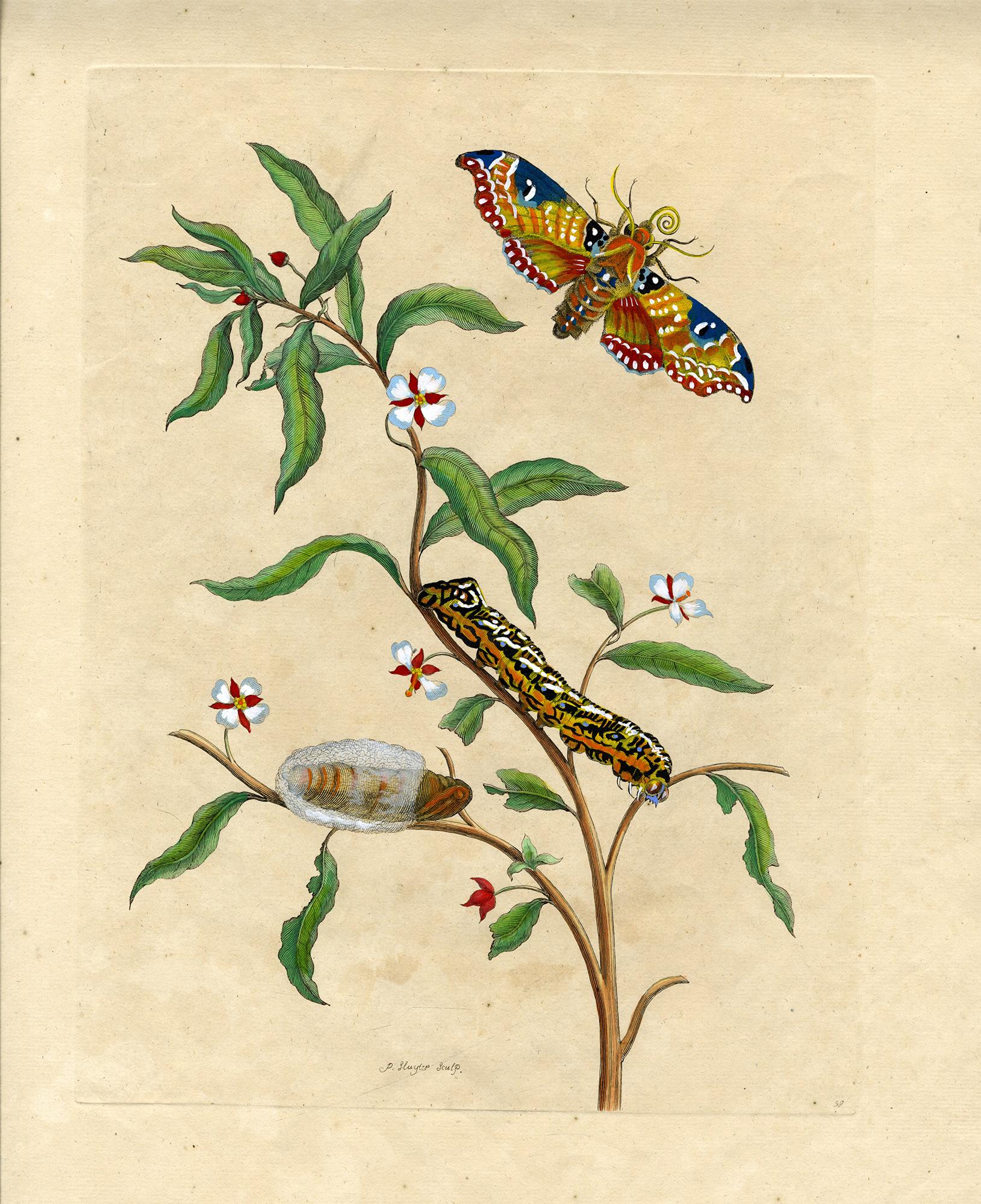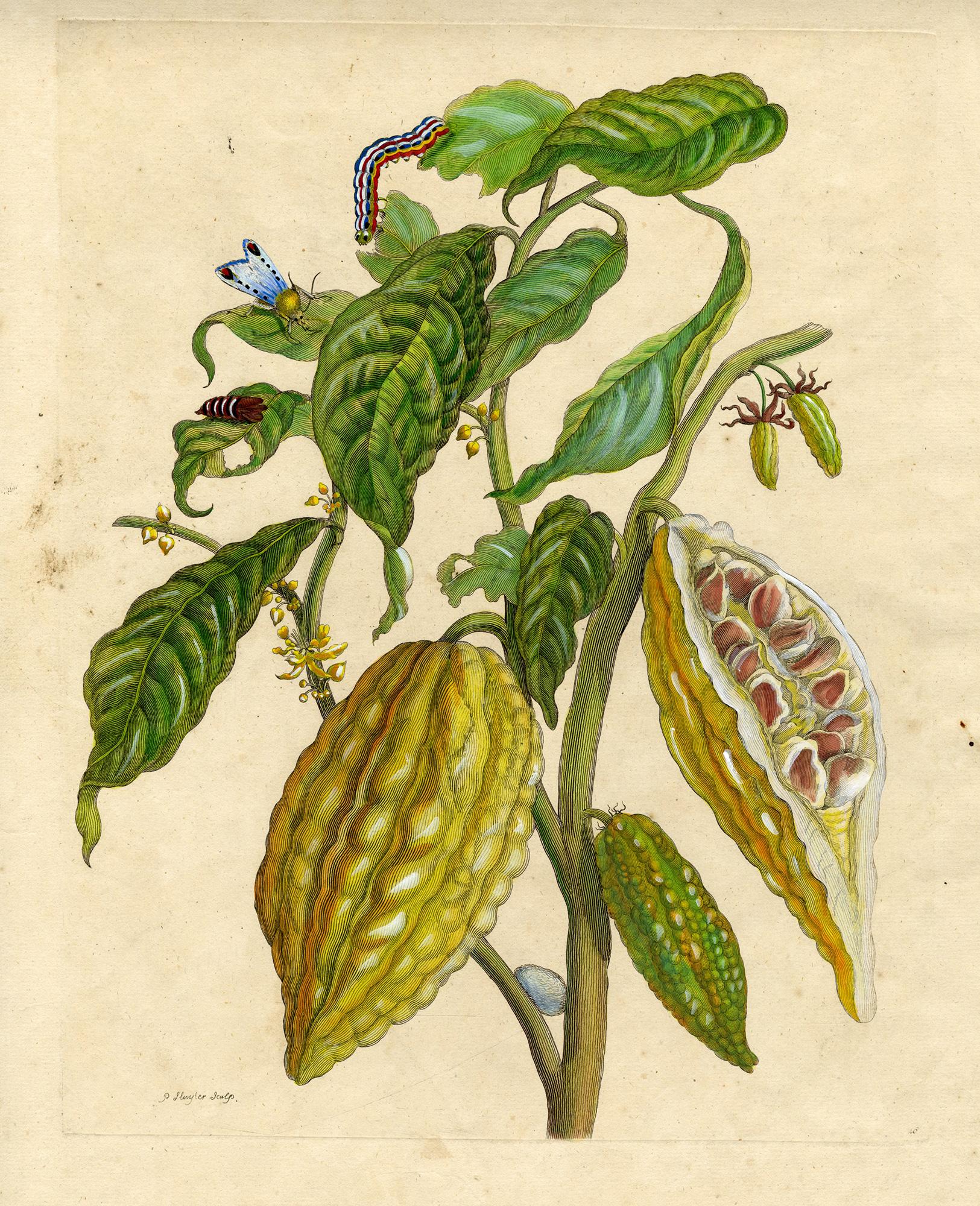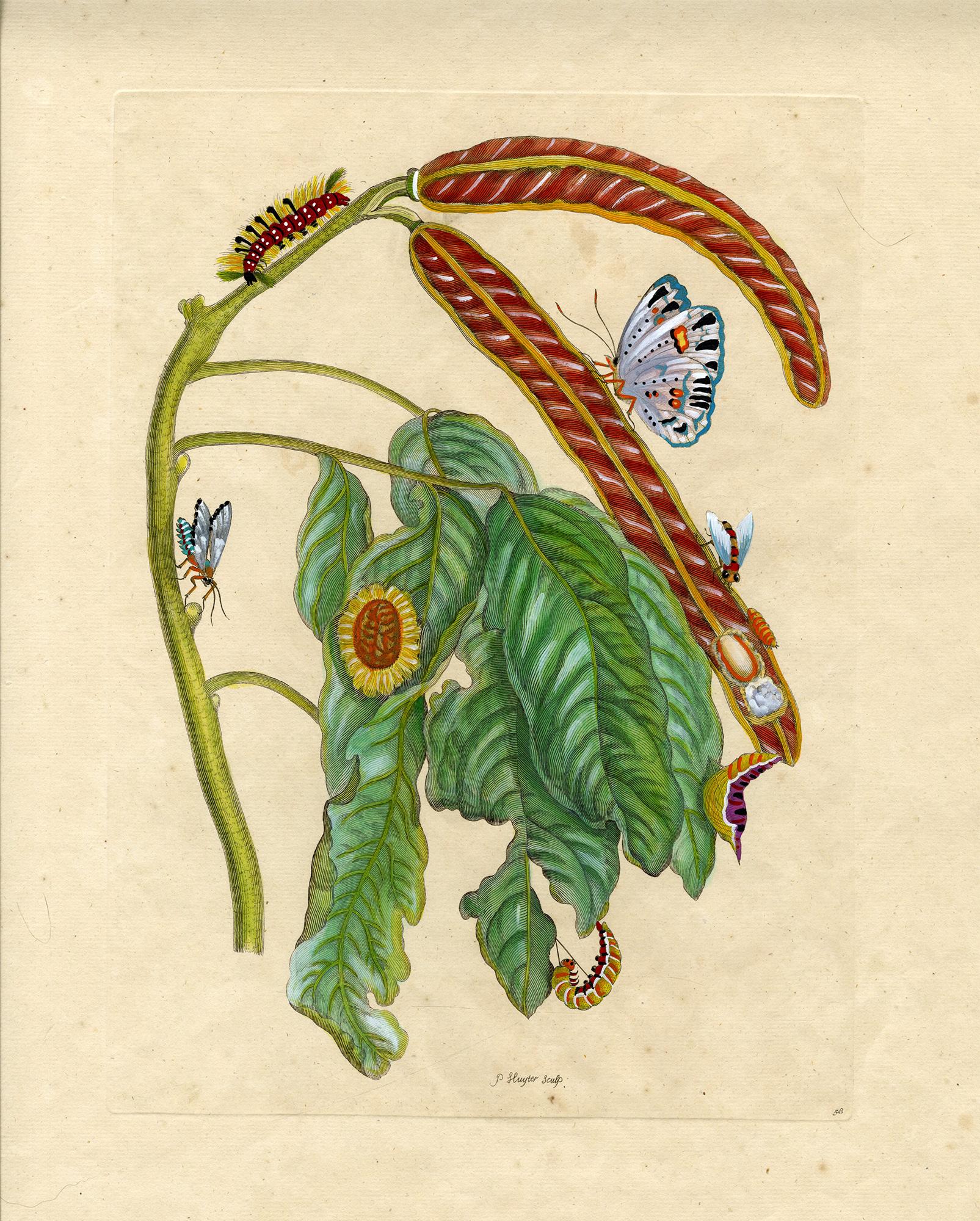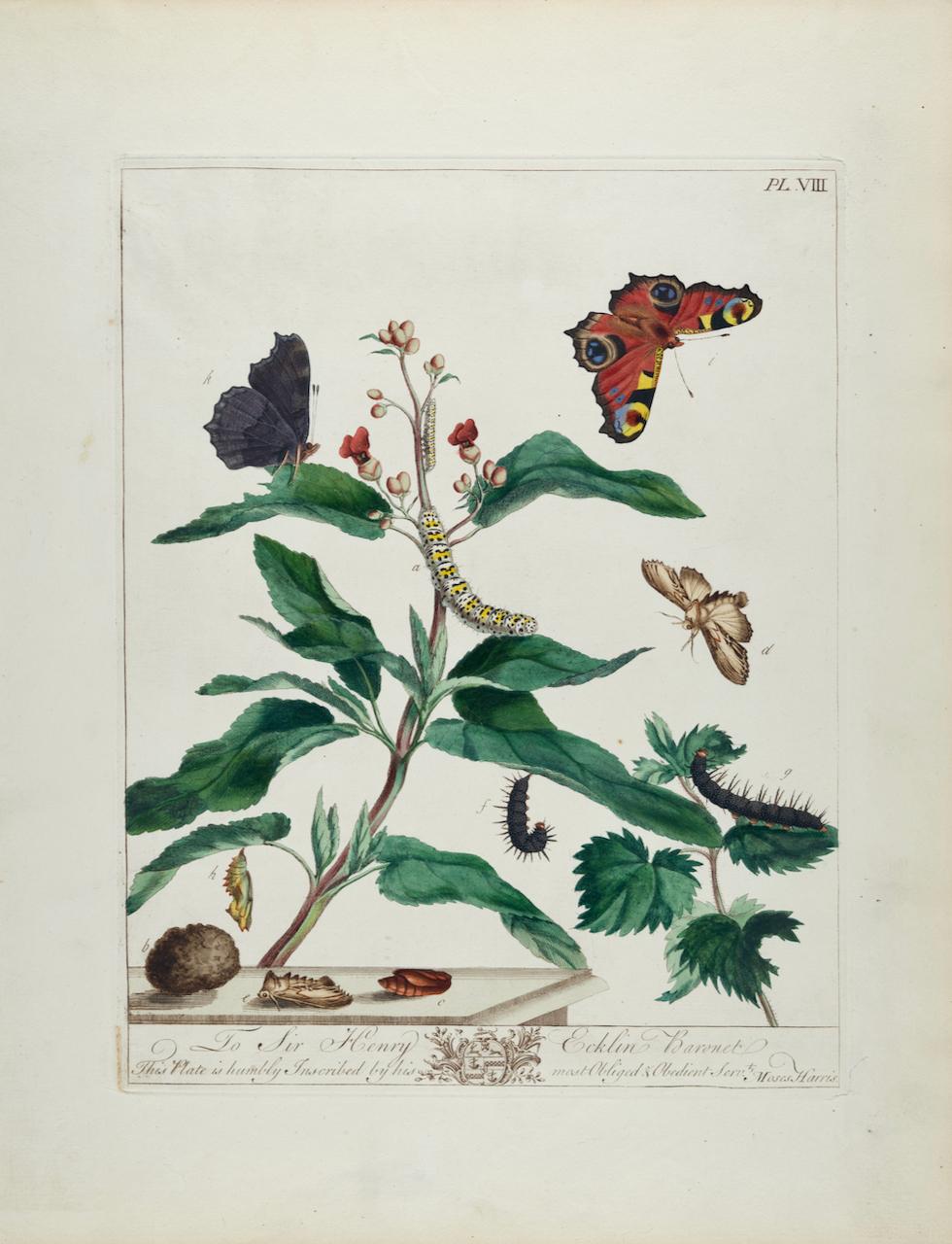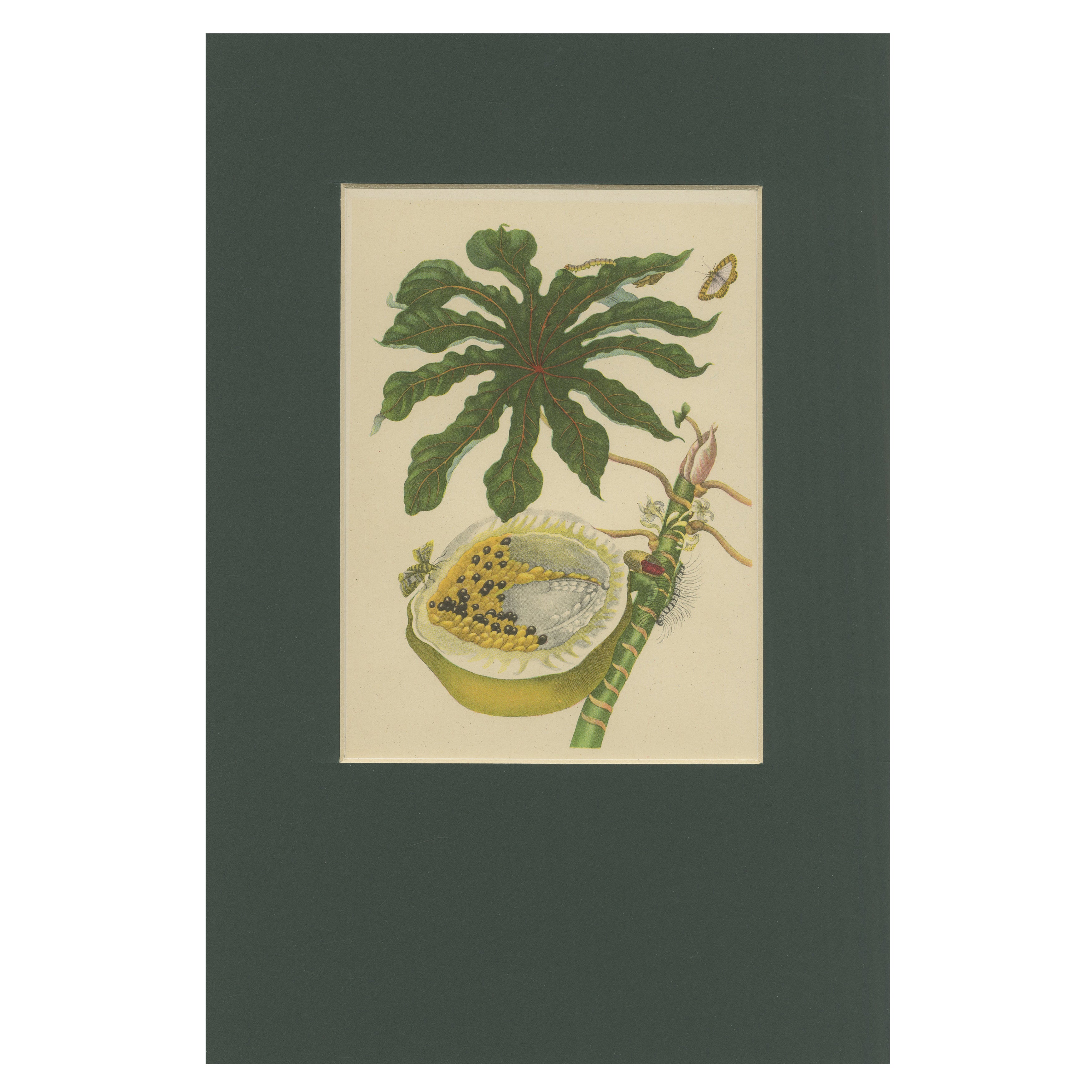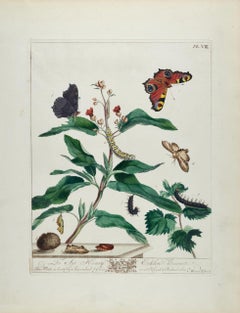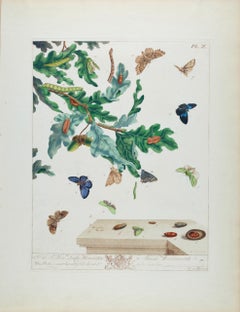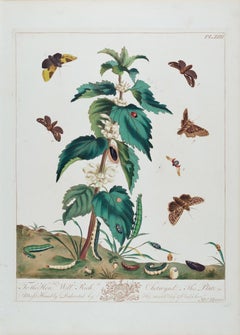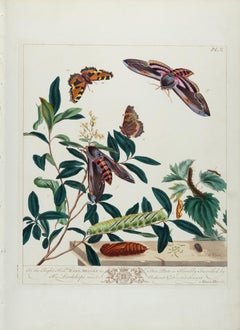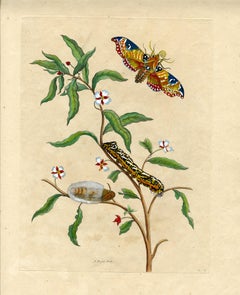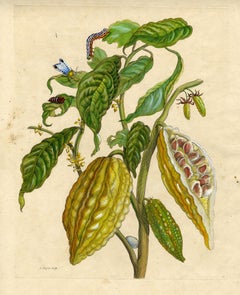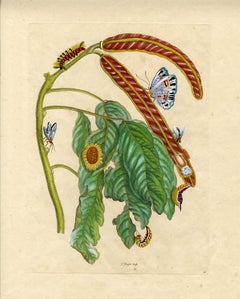Items Similar to Papaya and Moth Metamorphosis: 18th C. Hand-colored Engraving by Maria Merian
Want more images or videos?
Request additional images or videos from the seller
1 of 8
Papaya and Moth Metamorphosis: 18th C. Hand-colored Engraving by Maria Merian1730
1730
$5,575
£4,224.12
€4,846.84
CA$7,844.92
A$8,623.73
CHF 4,532.24
MX$104,723.50
NOK 56,538.52
SEK 53,566.27
DKK 36,173.21
About the Item
This exquisite hand-colored 18th century folio-sized engraving of a papaya plant and moth metamorphosis is plate 64 from Maria Sibylla Merian's publication 'Over de Voortteeling en Wonderbaerlyke Veranderingen der Surinaamsche Insecten' commonly known as 'Insects of Surinam'. This the first Dutch edition of the work which was published in Amsterdam by J. F. Bernard in 1730.
This beautiful, hand-colored 18th century engraving is printed on watermarked laid, chain-lined paper with wide margins. The sheet measures 21.88." high and 14.5" wide. It is in excellent condition, other than a few tiny spots.
Maria Sibylla Merian (1647—1717) was a naturalist and artist. Her contributions to entomology were never appropriately recognized in her lifetime. She is now considered to be a pioneer in the fields of botany and zoology. She made detailed observations of live specimens, which was a departure from previous studies that used preserved specimens. She focused great detail on the processes of metamorphosis, which had not been studied so comprehensively before her work.
The engravings for the publication were done by J. Mulder, P. Sluyter and A. Stopendaal, all after paintings on vellum by Merian. The work is considered to be one of the most beautiful, and famous illustrated natural history works of the 18th century.
The work was the result of Merian's trip in 1699 with her daughter Dorothea to Surinam, a Dutch colony on the northeastern coast of South America. The pair studied and recorded plants and insects for two years under difficult conditions. They came back to Amsterdam with specimens, notes and drawings and there completed their astounding work.
One naturalist proclaimed "Her portrayals of living insects and other animals were imbued with a charm, a minuteness of observation and an artistic sensibility that had not previously been seen in a natural history book; if Gould and Audubon have 'a spiritual ancestor, then it is difficult to think of a more worthy claimant to the title than Maria Sibylla Merian." On the day Maria Sibylla Merian died, Tsar Peter the Great purchased a two-volume collection of her unbound paintings, as well as her journal.
Born in Frankfurt am Main, Maria Sibylla Merian was the daughter of Matthaus Merian the Elder (1593—1650), a famous German-Swiss painter, engraver and publisher. Her father died when she was three and her mother remarried Jacob Marrel (1614-1681), who was a still-life painter. From the time she was eleven, Marrel schooled Maria Sibylla Merian in the tradition of northern European still life painting, working directly from life. As her interests evolved toward the study of insects, she employed these artistic skills to create her outstanding scientific and esthetically beautiful works. She was truly at the crossroads of art and science.
- Creation Year:1730
- Dimensions:Height: 21.88 in (55.58 cm)Width: 14.5 in (36.83 cm)
- Medium:
- Movement & Style:
- After:Maria Sibylla Merian (1647 - 1717, Dutch)
- Period:
- Framing:Framing Options Available
- Condition:
- Gallery Location:Alamo, CA
- Reference Number:Seller: # 50361stDibs: LU1173211611432
About the Seller
5.0
Gold Seller
Premium sellers maintaining a 4.3+ rating and 24-hour response times
Established in 2011
1stDibs seller since 2019
291 sales on 1stDibs
Typical response time: 1 hour
- ShippingRetrieving quote...Shipping from: Alamo, CA
- Return Policy
Authenticity Guarantee
In the unlikely event there’s an issue with an item’s authenticity, contact us within 1 year for a full refund. DetailsMoney-Back Guarantee
If your item is not as described, is damaged in transit, or does not arrive, contact us within 7 days for a full refund. Details24-Hour Cancellation
You have a 24-hour grace period in which to reconsider your purchase, with no questions asked.Vetted Professional Sellers
Our world-class sellers must adhere to strict standards for service and quality, maintaining the integrity of our listings.Price-Match Guarantee
If you find that a seller listed the same item for a lower price elsewhere, we’ll match it.Trusted Global Delivery
Our best-in-class carrier network provides specialized shipping options worldwide, including custom delivery.More From This Seller
View AllPeacock Butterfly, Moth & Botanical: An 18th C. Hand-colored M. Harris Engraving
By Moses Harris
Located in Alamo, CA
This is a rare, original first edition hand-colored engraving of Peacock Butterflies and Water Betony Moths depicted in their natural botanical environment, which is plate 8 from Mos...
Category
Mid-18th Century Landscape Prints
Materials
Engraving
Butterflies & Moths in a Landscape: 18th C. Hand-colored Engraving by M. Harris
By Moses Harris
Located in Alamo, CA
This is a rare, original first edition hand-colored engraving depicting the natural history of butterflies and moths, which is plate 10 from Moses Harris' publication "The Aurelian: ...
Category
Mid-18th Century Landscape Prints
Materials
Engraving
Moths and a Lady Bug in a Landscape: A Hand-colored Engraving by Moses Harris
By Moses Harris
Located in Alamo, CA
This is a hand-colored engraving depicting the natural history of moths and a lady bug, which is plate 22 from Moses Harris' publication "The Aurelian: or Natural History of English Insects; Namely Moths & Butterflies", first published in London in 1766 and this from an 1840 edition. The engraving depicts the natural history developmental stages of the Burnished Brass Moth, the Dark Gothic...
Category
Mid-19th Century Realist Landscape Prints
Materials
Engraving
Tortoise-shell Butterfly, Hawk Moth: Antique Hand-colored Engraving by M. Harris
By Moses Harris
Located in Alamo, CA
This is a hand-colored antique engraving depicting the natural history of the Tortoise-shell Butterfly and Privet Hawk Moth, which is plate 2 from Moses Harris' publication "The Aure...
Category
Mid-19th Century Realist Landscape Prints
Materials
Engraving
Butterflies & Moths in Nature: An Antique Hand-colored Engraving by Moses Harris
By Moses Harris
Located in Alamo, CA
This is a hand-colored antique engraving depicting the natural history of the the Brown Hairstreak Butterfly, the Larke Skipper Butterfly, the Small Skipper Butterfly, the Scarce Mar...
Category
Mid-19th Century Realist Landscape Prints
Materials
Engraving
Moths in Their Natural Landscape: Antique Hand-colored Engraving by Moses Harris
By Moses Harris
Located in Alamo, CA
This is a hand-colored engraving depicting the natural history of Pinkunderwing Moths, Cream Spotted Tyger Moths in their natural botanical environment, which is plate 4 from Moses H...
Category
Mid-19th Century Realist Landscape Prints
Materials
Engraving
You May Also Like
Tree with moth, caterpillar..., Plate 39, Metamorphosis Insectorum Surinamensium
By Maria Sibylla Merian
Located in Middletown, NY
Metamorphosis Insectorum Surinamensium, Plate No. 39; Unidentified tree with moth, caterpillar and pupa.
The Netherlands: 1705....
Category
Early 18th Century Naturalistic Still-life Prints
Materials
Watercolor, Engraving
Cocoa plant, caterpillar, ..., Plate 26, Metamorphosis Insectorum Surinamensium
By Maria Sibylla Merian
Located in Middletown, NY
Metamorphosis Insectorum Surinamensium, Plate No. 26; Cocoa plant, caterpillar, pupa, and butterflies. The Netherlands: 1705. En...
Category
Early 18th Century Naturalistic Still-life Prints
Materials
Watercolor, Engraving
Thistle and Moths, plate no. 6, Metamorphosis Insectorum Surinamensium
By Maria Sibylla Merian
Located in Middletown, NY
Metamorphosis Insectorum Surinamensium, Plate No. 6; Thistle and Moths. The Netherlands: 1705. Engraving with hand coloring in w...
Category
Early 18th Century Naturalistic Still-life Prints
Materials
Watercolor, Engraving
Icecream Bean plant..., plate no. 58, Metamorphosis Insectorum Surinamensium
By Maria Sibylla Merian
Located in Middletown, NY
Metamorphosis Insectorum Surinamensium, Plate No. 58; Ice Cream Bean Plant, Cloudless Sulphur Butterfly and Caterpillar with Mot...
Category
Early 18th Century Naturalistic Still-life Prints
Materials
Watercolor, Engraving
Papaya and Insects – 19th-Century Hand-Coloured Lithograph after Merian Plate 45
Located in Langweer, NL
Heliconia with Insects – After Maria Sibylla Merian, Plate 54 from Metamorphosis insectorum Surinamensium, 19th-century lithograph
Description:
A fine 19th-century hand-coloured lit...
Category
Antique 1870s German Prints
Materials
Paper
4 plates from The Wondrous Transformation of Caterpillars & their Strange Diet..
By Maria Sibylla Merian
Located in Middletown, NY
Four plates from The Wondrous Transformation of Caterpillars and their Strange Diet of Flowers. “Wolfsmelk Rupsen;" “Wolfsmilch, Raupe und Schmetterling" Amsterdam: JF Bernard, 1730. Each an engraving with hand coloring in watercolor and gouache printed on one sheet of watermarked Honig cream laid paper, each measures 6 1/4 x 5 inches (157 x 121 mm), sheet measures 20 5/8 x 14 inches (522 x 355 mm), full margins. With handling creases in the lower right sheet quadrant, as well as minor, loose cockling, otherwise in very good condition. The colors are superb with exceptionally fresh and bright saturation. Engraved between 1679 and 1683, printed 1730. Plates included: CXLI, CXLII, CXIII & CXLIV.
MARIA SIBYLLA MERIAN was one of the most highly respected entomologists of the 17th century, and remains today one of the field's most significant figures. A German-born naturalist and scientific illustrator, she reared herself on the study of caterpillars, and made tremendous contributions to the knowledge of the life cycles of numerous species. Until her detailed and careful study of the process of metamorphosis it was thought that insects were "born of mud," through spontaneous generation.
Trained as a miniature painter by her stepfather, she published her first book of illustrations in 1675, at the age of 28. In 1679, Merian published the first volume of the two-volume series on caterpillars, The Wondrous Transformation of Caterpillars and their Strange Diet of Flowers; the second volume followed in 1683. Each volume contained 50 plates that she engraved and etched. In 1699, Merian traveled to Dutch Guiana...
Category
Early 18th Century Naturalistic Still-life Prints
Materials
Watercolor, Engraving
More Ways To Browse
18th Century Colored Engraving
Antique Moth
Matthaus Merian The Elder
Lowell Nesbitt Tulip
Antique Botanical Prints Australia
Hunt Slonem Serigraph
Jean Louis Prevost
Antique Garden Seeder
Kusama Flowers
Sunflower Botanical Print
Dick English
Ellen Gunn
Brooklyn Brownstone
Peter Blake I Love You
Physica Sacra
Still Life With Picasso
Unsigned Warhol
Vintage Daffodil Prints
